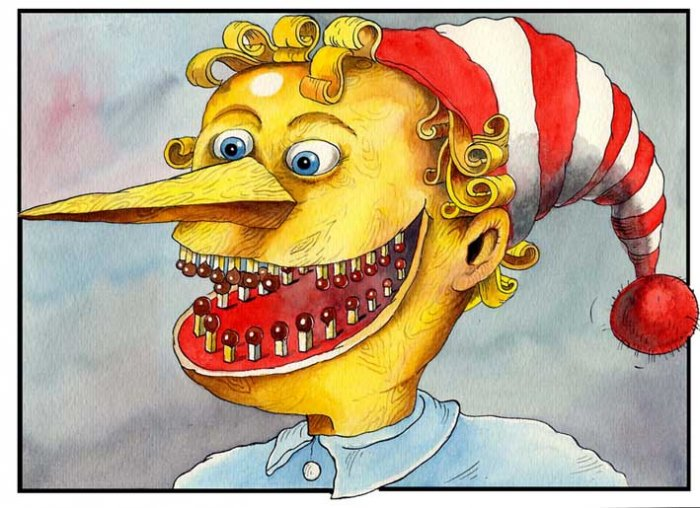Pathological Liars
When the need to attract attention and dazzle others with one’s personality combines, on one hand, with an overly excitable, vivid, and immature imagination, and on the other—with more pronounced moral defects than those seen in hysterics—a picture emerges of the type of psychopathy that Delbrück called pseudologia phantastica, Dupré referred to as mythomania, and which Kraepelin more bluntly and accurately described as “liars and tricksters.”
Most often, these are people whose abilities cannot be denied. They are quick-witted, resourceful, rapidly absorb new information, possess the gift of gab, and know how to use any knowledge or skill they have to their advantage. They may appear well-educated, even scholarly, while actually having only a superficial grasp of facts picked up from encyclopedias and popular brochures. Some have artistic or poetic inclinations, write poetry, draw, play music, or have a passion for theater. They quickly make acquaintances, adapt well to people, and easily gain their trust.
They know how to carry themselves with dignity, are skillful, often elegant, and care greatly about their appearance and the impression they make on others. Sometimes, a flashy outfit is the only real possession such a person has. Importantly, despite their abilities, these individuals rarely show genuine interest in anything other than themselves and suffer from a complete lack of diligence and perseverance. They are superficial, unable to force themselves to concentrate for long, easily distracted, and scattered. Their intellectual interests are shallow, and any work requiring persistence, accuracy, and thoroughness repels them. As Kraepelin put it, “Their thinking lacks order, planning, and coherence; their judgments lack maturity and depth; and their entire perception of life lacks seriousness and depth.”
Of course, one cannot expect moral stability from them either: being frivolous, they are incapable of deep feelings, are capricious in their attachments, and usually do not form lasting relationships. They lack a sense of duty and love only themselves.
The Fatal Flaw: Unrestrained Imagination
Their most disastrous trait is the inability to control their imagination. With their passion for showing off and creating illusions, they are completely unable to resist the temptation to use their vivid, detailed, and colorfully embellished fantasies for this purpose. This leads to an irresistible and often extremely harmful compulsion to lie. They lie artfully, masterfully, becoming so carried away by their own lies that they almost forget they are lying. Often, they lie for no reason at all, just to impress or astonish their audience.
Most often, their fabrications concern themselves: they eagerly tell stories about their noble origins, high-level connections, important positions they have held or currently hold, or their immense wealth. With their rich imagination, it’s easy for them to describe in minute detail the setting of a nonexistent villa they supposedly own, and even go so far as to take doubters to someone else’s villa, passing it off as their own to “prove” their story.
But they don’t always stop at harmless lies. Some lie naively and innocently, like children, driven by the desire to show off with ever-new images conjured by their imagination. Most, however, derive tangible benefits from their lies. These include numerous con artists posing as important people traveling incognito, charlatans claiming to be doctors or engineers, who often manage to keep those around them under the spell of their deception for some time, as well as card sharks, forgers, and even petty street swindlers who extract money from gullible people with stories of misfortune or promises to use their “connections” to provide some important service.
Their self-control in these situations can be astonishing: they lie with such confidence, without embarrassment, and can wriggle out of tight spots so easily—even when cornered—that they involuntarily inspire admiration.
Reactions to Exposure and Comparison with Other Types
Many do not lose heart even when caught. Kraepelin tells of one such swindler who, after a stay in a clinic, so impressed the police officer sent to escort him back to prison with his proud, aristocratic demeanor that the officer obligingly carried his belongings for him. However, in the end, these individuals are less resilient when faced with the “blows of fate”: when exposed and seeing no way out, they easily fall into complete despair and lose all dignity.
Certain traits link these psychopaths to a specific group of hysterics. The main difference is that in pathological liars, dishonesty overshadows all other personality traits. Moreover, hysterics rarely cross the boundaries of criminal law in their antics, whereas pseudologues are often encountered by forensic and prison psychiatrists.
The difference between pseudologues and dreamers is even more pronounced. They share only one trait—an overly excitable imagination. As Kronfeld cleverly put it, while the dreamer deceives himself about the outside world, the pseudologue deceives others about himself. That the latter sometimes begins to believe his own lies is merely a side effect, not the essence of his behavior.



